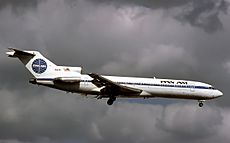Pan Am Flight 759 facts for kids

A Pan Am Boeing 727-200 similar to the aircraft involved in the accident.
|
|
| Accident summary | |
|---|---|
| Date | 9 July 1982 |
| Summary | Microburst-induced wind shear |
| Place | Kenner, Louisiana United States 29°59′15″N 90°14′08″W / 29.98750°N 90.23556°W |
| Passengers | 138 |
| Crew | 7 |
| Fatalities | 145 |
| Survivors | 0 |
| Aircraft type | Boeing 727-235 |
| Aircraft name | Clipper Defiance |
| Airline/user | Pan Am |
| Registration | N4737 |
| Flew from | Miami International Airport |
| 1st stopover | New Orleans Int'l Airport |
| Last stopover | McCarran Int'l Airport |
| Flying to | San Diego Int’l Airport |
Pan Am Flight 759 was a domestic flight in the United States. It was traveling from Miami, Florida, to San Diego, California. The flight had planned stops in New Orleans, Louisiana, and Las Vegas, Nevada.
On July 9, 1982, the plane took off from New Orleans. Shortly after leaving the ground, it crashed into a neighborhood in Kenner, Louisiana. All 145 people on board the plane died. Sadly, eight more people on the ground also lost their lives.
Contents
What Happened to Flight 759?
Pan Am Flight 759 was a Boeing 727 aircraft. It was carrying 138 passengers and 7 crew members. The plane was named Clipper Defiance.
The flight took off from Louis Armstrong New Orleans International Airport. This happened at 4:07 PM local time. The weather was very stormy that day.
The Sudden Crash
Just seconds after takeoff, the plane flew into a strong microburst. A microburst is a powerful downdraft of air. It creates dangerous wind shear. Wind shear means the wind changes direction and speed very quickly.
This sudden change in wind made the plane lose lift. It also pushed the plane downwards. The pilots tried to control the aircraft. However, they could not recover from the sudden drop.
The plane crashed about 4,600 feet (1,400 meters) from the end of the runway. It hit a residential area in Kenner. The crash destroyed six houses and damaged five others.
Why Did It Happen?
Investigators found that the main cause was the microburst. The strong winds pushed the plane down. This made it impossible for the plane to climb.
The crew also had limited information about the severe weather. Air traffic control did not have advanced radar. This radar could detect microbursts.
After this accident, new systems were developed. These systems help pilots detect wind shear. They also help air traffic controllers warn pilots. This has made flying much safer.
After the Accident
The crash of Pan Am Flight 759 was a major disaster. It led to important changes in aviation safety.
- New weather radar systems were created. These systems can spot microbursts.
- Pilots received better training. This training helps them react to wind shear.
- Airports improved their weather monitoring.
These changes have helped prevent similar accidents. The lessons learned from Flight 759 made air travel safer for everyone.
See also
 In Spanish: Vuelo 759 de Pan Am para niños
In Spanish: Vuelo 759 de Pan Am para niños

